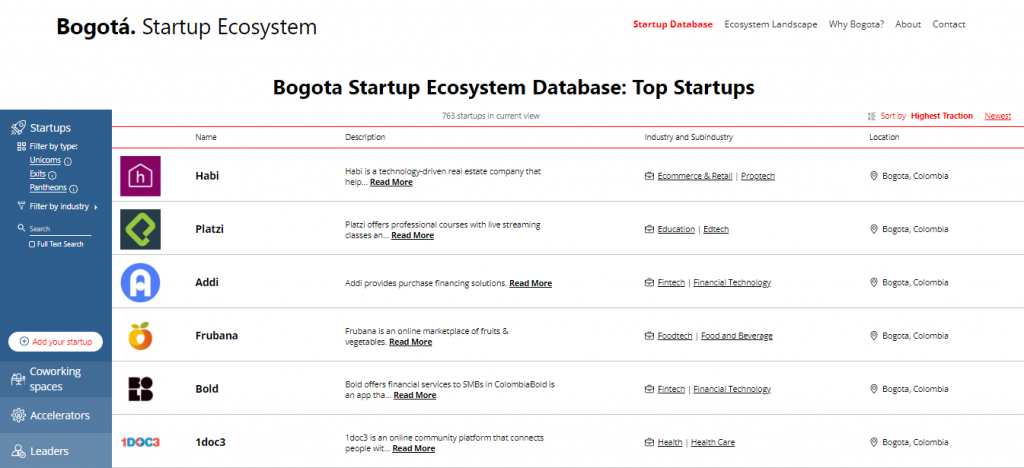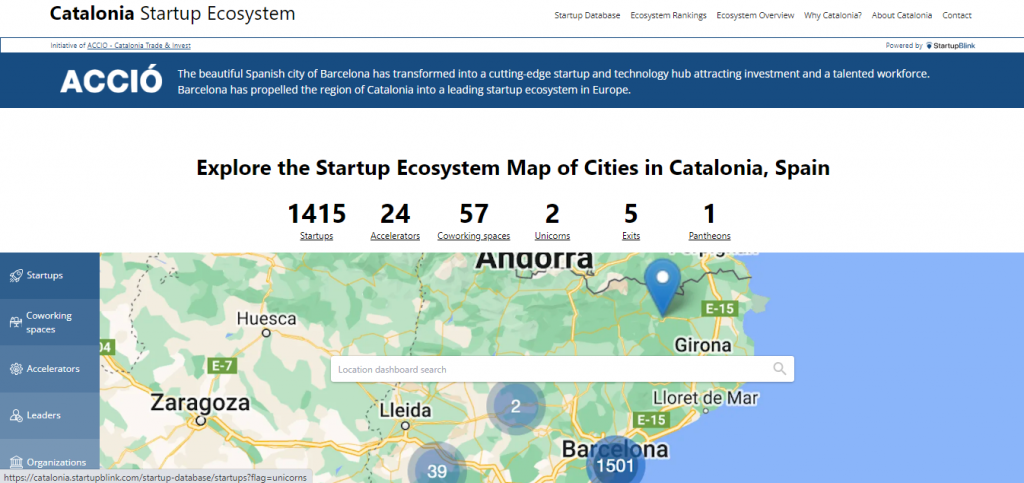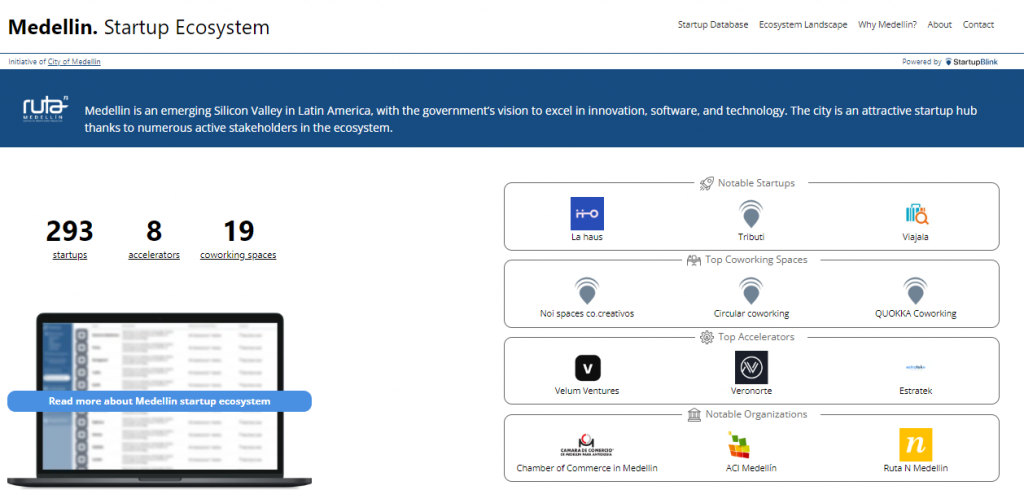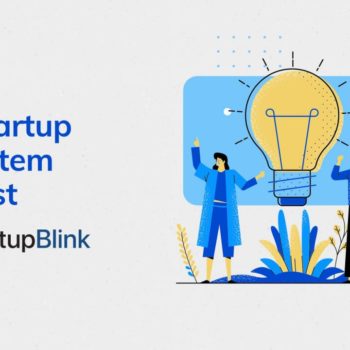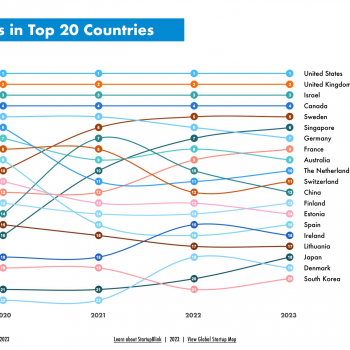A comprehensive startup ecosystem database can help you to allocate resources better, improve information flow, foster collaboration, and drive innovation. Additionally, it is a way to showcase resources and opportunities available in your ecosystem to entrepreneurs and startups interested in relocation or building a business overseas. This is an essential part of building a thriving startup ecosystem. In this article, you can learn about the components, advantages, and promotional value of building a startup ecosystem database.
What is a Startup Ecosystem Database?
A Startup Ecosystem Database also known as startup ecosystem portal is a dynamic platform that offers a visual representation of a startup ecosystem’s web of connections. It serves as a comprehensive database, encompassing a diverse array of stakeholders spanning regions, countries, cities, and specific industries. It captures the essence of each contributor within the ecosystem, fostering an environment of collaboration and growth.
As a global startup ecosystem map and research center, StartupBlink stands as a prominent player in deploying startup ecosystem databases. We specialize in crafting tailored solutions with fully customized, branded, and crowdsourced databases that act as a bridge, seamlessly linking your organization to your startup ecosystem.
Who Can Benefit from a Startup Ecosystem Database?
1. Public Sector Organizations:
For governments and the public sector, nurturing startups fuels economic growth and innovation. The Portal becomes a strategic tool to streamline communication, allocate resources effectively, and support policy initiatives that drive entrepreneurial activity. It’s a platform to interact with startups, gather insights, and implement initiatives that foster a conducive environment for innovation to flourish.
2. Private Sector Organizations:
Enterprises seeking growth avenues find a treasure trove in the Startup Ecosystem Portal. It’s a space to engage with startups, spot innovation trends, and foster partnerships that create mutual perks. Whether it’s collaborating on initiatives, sourcing innovative solutions, or exploring potential acquisitions, private sector organizations can within this interconnected ecosystem.
3. Startups
At the heart of it all, startups find their pool of support within the Portal. It’s a hub where they access resources, investors, and collaborative partnerships. The Portal supports their journey, helping them navigate the challenges of entrepreneurship and discover pathways to growth that may have otherwise remained concealed.
4. Investors:
Investors, seeking promising ventures to support, discover a curated landscape of opportunities. The Portal presents a comprehensive view of startups, their offerings, and growth trajectories. This information empowers investors to make informed decisions, channel their resources effectively, and foster a flourishing investment ecosystem.
5. Accelerators & Incubators:
Institutions focused on nurturing startups find the Portal to be a space of strategic value. It’s a medium to identify potential candidates for acceleration, connect with promising ventures, and offer resources that expedite growth.
6. Global Talent:
Talented individuals worldwide seek environments where their skills can flourish. The Portal serves as a guide to such opportunities. From job seekers finding positions in dynamic startups to researchers discovering institutions aligned with their expertise, the Portal facilitates connections that enable global talent to contribute and thrive within the ecosystem.
Benefits of a Startup Ecosystem Database
For Your Organization
Lead Generation and Partnerships:
The Startup Ecosystem Portal provides a direct line of communication with startups and essential stakeholders. Reach out effortlessly to startups, universities, governments, and corporations that are either on the map or have accessed your portal. This opens avenues for collaboration, partnerships, and knowledge exchange.
Expand Brand Recognition:
The portal becomes your canvas to display not just your ecosystem’s achievements, but also your organization’s role in fostering growth. Utilize brand assets, databases, maps, and original research to tell your story. This not only raises brand recognition but also establishes you as a significant player in the ecosystem’s development.
Comprehensive Data & Research:
A robust database isn’t just about quantity; it’s about quality. By building a comprehensive repository of startups and ecosystem stakeholders, benchmarked against industry standards, you provide a valuable resource. This data-driven approach aids in making informed decisions, offering insights that steer internal growth strategies and partnership initiatives.
Thought Leadership:
Building a database with StartupBlink unlocks various other opportunities for your organization, such as joining the Startup Ecosystem Podcast or webinars powered by StartupBlink. Generating unique insights and content about your ecosystem empowers you to be a thought leader within the ecosystem. These activities not only elevate your organization’s reputation but also contribute significantly to the collective understanding of ecosystem dynamics.
For Your Ecosystem:
1. Fostering Talent Attraction:

Imagine your ecosystem as a magnet for talent. With the Startup Ecosystem Portal, you create an environment that draws skilled individuals eager to contribute and innovate. Startups, established companies, investors, and educational institutions gain a platform to showcase their offerings, making it easier for talented individuals to identify opportunities and become part of your ecosystem.
2. Attracting Investment:
The Portal has a guiding potential for investors to discover promising startups and impactful initiatives across various industries and sub-industries within your ecosystem. By providing a clear, organized view of investment prospects, you cultivate an environment that encourages funding, accelerates business growth, and fortifies your ecosystem’s financial foundation.
3. Empowering Startups:
The Startup Ecosystem Portal becomes a lifeline for emerging startups, offering a gateway to resources, and collaboration opportunities. As startups access a centralized hub of support, they’re better equipped to navigate challenges, seize growth prospects, and evolve into prominent players within the ecosystem.
4. Enhancing Networking:

Connections are the currency of progress. With the Startup Ecosystem Portal, networking takes center stage. Whether it’s startups connecting with potential partners, investors seeking promising ventures, or collaborators finding common ground, the Portal accelerates interactions. It’s a virtual space where relationships flourish, leading to collaborations that drive innovation and amplify collective success.
5. Gaining Insights:
Your Portal isn’t just about facilitating connections; it’s also a platform of insights. By curating data and generating content, the Portal equips stakeholders with valuable information about ecosystem trends, performance benchmarks, and emerging opportunities. These insights empower decision-makers to steer their initiatives strategically and contribute to the ecosystem’s sustained growth.
Types and Use Cases of Startup Ecosystem Databases:
Regional Startup Ecosystem Databases
These databases are the windows to a specific region’s startup ecosystems. They gather startups, investors, accelerators, and other stakeholders within a geographical area, creating a cohesive network that drives local innovation. Regional databases are a hub for identifying growth opportunities, fostering collaborations, and showcasing the collective potential of a specific locale.
City Focused Startup Ecosystem Portal
Cities are bustling hubs of innovation, each with its unique ecosystem. City Focused databases delve into the heartbeat of urban innovation, spotlighting startups, investors, and resources within a city’s boundaries. These databases empower city-specific initiatives, foster local partnerships, and establish the city as a thriving hub for entrepreneurship and innovation.
Industry Specific Startup Ecosystem Portal
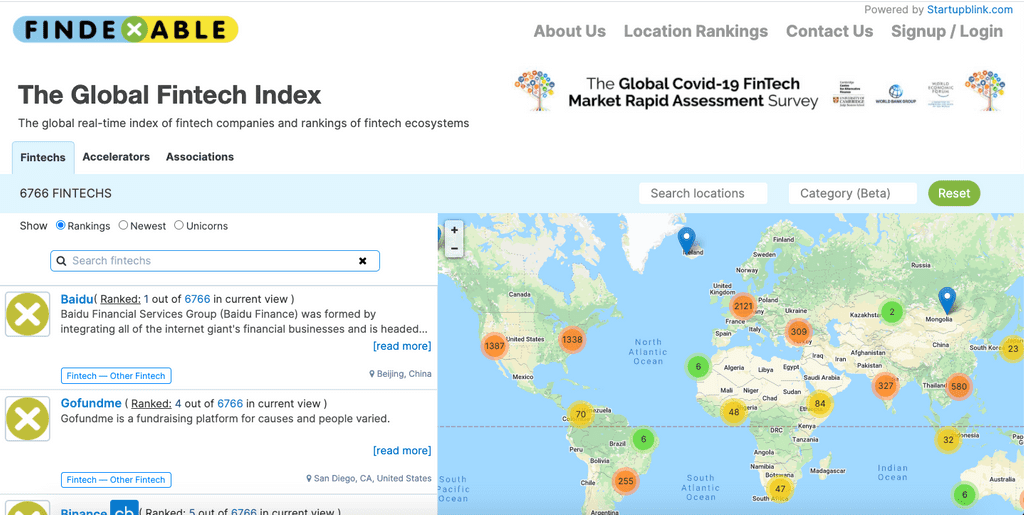
Industry Specific databases cater to these specialized needs. Whether it’s artificial intelligence,fintech, healthtech, or any other sector, these databases curate a space where startups, investors, and stakeholders within a specific industry find tailored opportunities and collaborations. They accelerate innovation within these niches and drive focused growth.
Findexable is an example showcasing the best Fintech Ecosystems in the world, built in partnership with StartupBlink.
Next Step: Getting Ready to Build Your Startup Ecosystem Database
As you partner with StartupBlink, our expert team will take care of all the steps required to build a fully customized startup ecosystem portal. Through the portal, your organization gains more than just visibility—it becomes a central force in fostering growth, innovation, and collaboration. With comprehensive data, thought leadership opportunities, and direct access to startups and stakeholders, your impact is amplified. For the ecosystem as a whole, these databases become catalysts for attracting talent, investments, and insights that drive collective progress.

